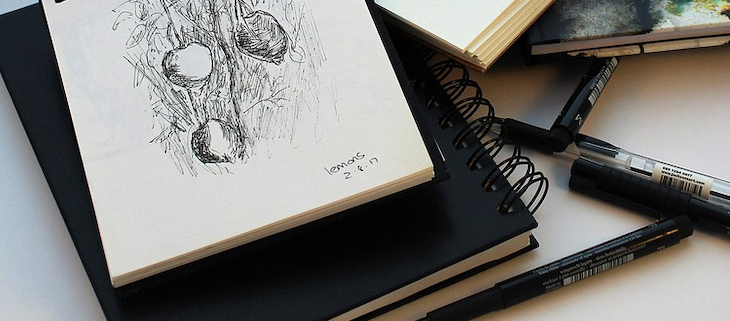The modern world has propelled many artists in the direction of digital drawing. But how does this differ from the conventional method, and is it worth it to switch?
In today’s digitised world, there are still many artists that prefer traditional drawing using only a sketchpad and medium. Read on to discover the core differences between digital and conventional drawing and decide which one is more suitable for you.
What Are the Advantages of Traditional Drawing?
Traditional drawing has a lot of perks. Probably the biggest one is that traditional drawing doesn’t rely on electricity or batteries. This means that you can draw anywhere you want – on a mountain top, at the beach, or simply when commuting to work or school. All the tools you need are a sketchbook and the right pencils.
On the other hand, digital drawing tethers you to your computer and tablet. This makes it harder to express yourself whenever inspiration strikes. By the time you get to your tablet, you might not remember the brilliant creative idea you had on the bus.
Drawing on an art sketchpad offers many benefits. These items are affordable, portable, versatile, and widely available. They come in different shapes and sizes and allow you to express your ideas anywhere in the world. You can use them for different purposes and keep track of your progress and mistakes as an artist.
You Can Draw Anywhere with Sketchpads
Having access to simple drawing tools can inspire creativity. Sketchpads come in a variety of sizes, so you’ll easily find an art sketchpad that fits in your bag or backpack. They’re convenient to carry anywhere you go. Simply leave it in a visible spot, such as the coffee table by the front door, and you can snatch it whenever you leave the house.

Sketchbooks Have Many Uses
These items serve a variety of different purposes in addition to, well, drawing. They can serve as diaries, calendars, vacation notebooks, places to practice writing and press fall leaves, or even somewhere to put souvenirs, pictures, or other knickknacks. On the backside, you can even keep a grocery list, or doodle interesting things and add daily notes like “Pancakes for breakfast!”
Your art sketchpad can take the place of many other organisers and inspire you to add extra decorations to your to-do list.
Record Your Progress
Learning to draw is a tough journey, and your sketchbook keeps a record of your artistic capabilities, observations, and accomplishments. When you quickly flick through it, you can see the progress you’ve made in the past weeks or months. This helps you appreciate your hard work even more!
Sketchpads Help You Improve
When you’re drawing, every mistake feels like a defeat, yet it may actually be a time of tremendous progress. A drawing book records both the good and the bad aspects of your artistic development. All of your scribbles are linked together, which makes it harder to throw away the whole thing.

Even if your sketchbook includes a lot of nasty drawing mistakes, you can still document them and learn at your own pace. So, order your favourite sketchpad online and start improving your artistic skills!
The Pros of Digital Drawing
With digital drawing, you have many paintbrush and colour possibilities at your disposal. You also have more control over your artwork thanks to the ability to combine multiple layers and undo your mistakes. Here are the benefits of drawing digitally:
- No scanning required: Digital sketching will spare you the added step of needing to scan your work. It’s handier because you’ll be creating your work in the same space where you’ll finish it and display it afterward;
- More possibilities: With digital drawing, the options are limitless. Edit, move, scale, and colour your designs with an almost infinite number of options!
- It’s faster: Speaking about speed, sketching digitally helps you work at a much faster pace than if you drew on paper. If you know what you’re doing, you can complete tasks that would take many hours on paper in half the time or less. When you start working on bigger and more complicated projects, this speed and momentum come in handy.
The Cons of Digital Drawing
- It encourages nit-picking: You’ll find yourself worrying over subtleties that you wouldn’t have if you were working on paper since you can zoom in and tweak endlessly;
- Higher cost: While sketchpads and pencils are quite affordable, drawing tablets and software are pricy;
- The issue of mobility: With a sketchbook, you can spend the afternoon drawing in the park. However, you can’t do the same with a graphics tablet;
- You can lose your work: This happens in the case of a sudden hardware failure or power outage. With paper, you won’t have to worry about that (until you accidentally spill coffee on it, so be careful)!
- Loss of authenticity: Famous paintings are expensive because there’s only one original copy of each masterpiece in existence. Having the sole original copy of anything provides uniqueness. Then, what about a computerized piece of art? Since you would just print out duplicates of it to sell, each one isn’t as “genuine” or “original” as the one you initially worked on.
How Are They Similar?
If you want to create anything of value, you need to understand the fundamentals of sketching. Otherwise, you’ll create poor drawings, whether you’re using paper or a drawing tablet. Digital drawing will offer you some protection, but to create an outstanding art piece, you must be a skilled artist.
Moreover, it takes persistence, tenacity, and consistency to be good at both. So, instead of seeing these two methods as competitors, see them as tools that will help you become a better artist!




















